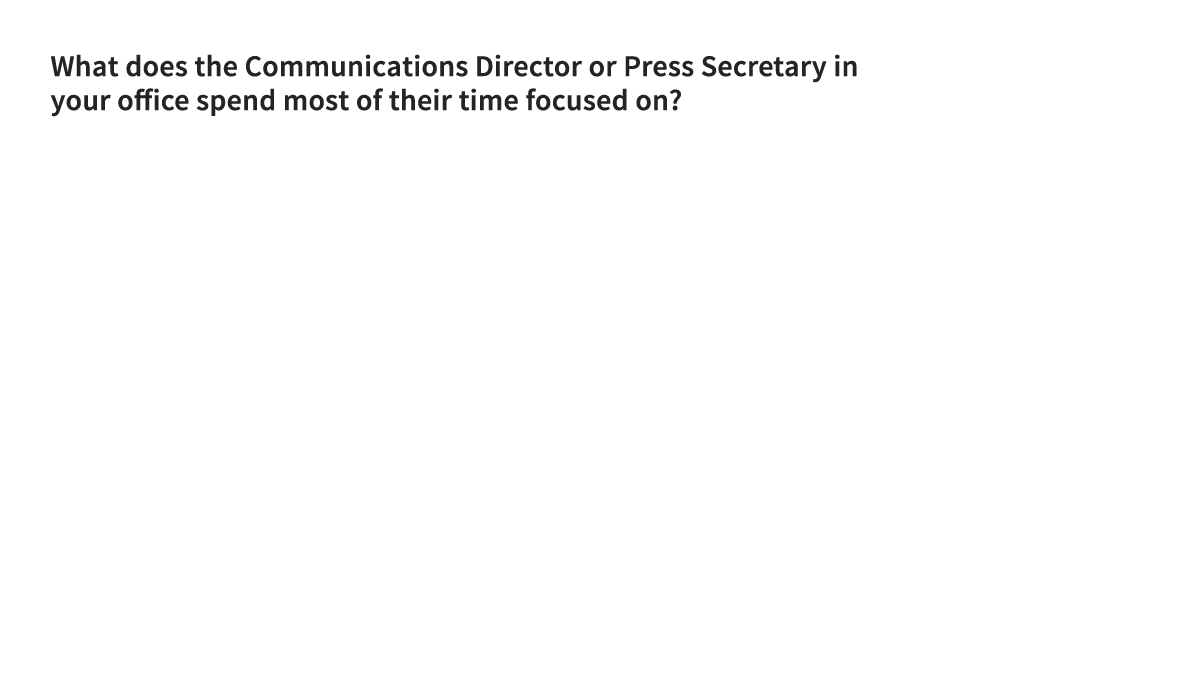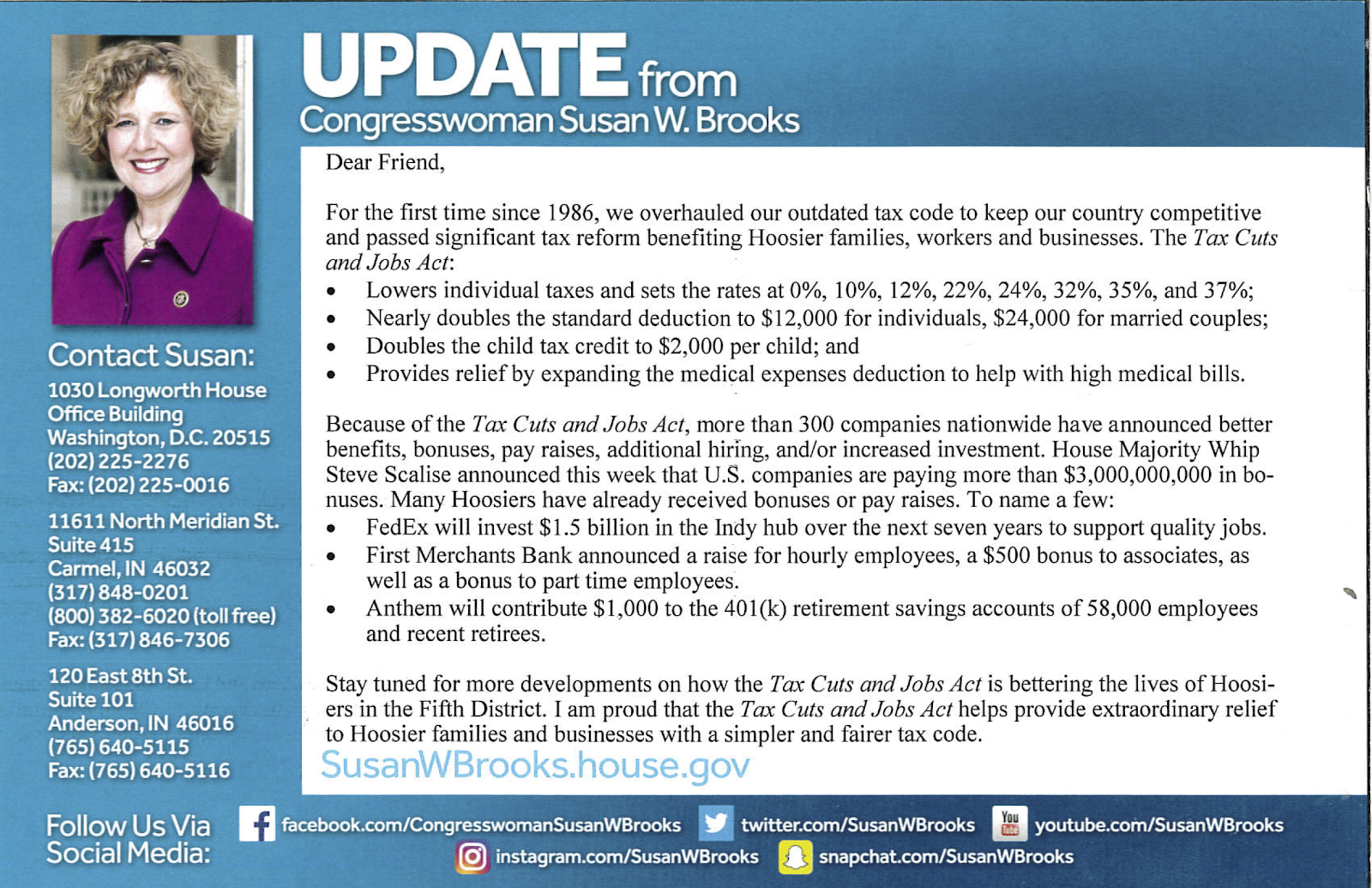House staff rate four communications channels as very important in their communications strategy: Email, Facebook (as the primary example of social media), traditional press, and franked mail. Here, we take a look at how each in turn is used, adding to them teletownhalls, which ranked highly on our survey’s trust metrics.
Email: (Still) King of the Hill
Despite the media’s emphasis on social media, and the allure of newer communications channels like texting, email newsletters are the most prominent form of communication in the House. Some offices report success in building email large email lists, with some offices building lists of nearly 100,000 recipients.
To build email lists, offices can rent lists of voters in their district and send them an email inviting them to opt-in to receive the Member’s email newsletter. They also run Facebook advertising for the same purpose. Some may also offer tear-off cards in franked mail pieces where a constituent can enter their email and be opted-in to the newsletters. Across mediums, Member offices employ strategies like getting the recipient to take a quick survey, increasing response rates. All of these initial acquisition methods are paid communications subject to franking approval, but once an email newsletter subscriber is opted-in, the office can email them again and again without having to get approval each time.
This success is most commonly seen by longer-tenured Members who have built up email lists over numerous terms, while newer members struggle to find the same value without investments in list acquisition beyond the one-time transfer of campaign email lists they are allowed.
The average office surveyed reports having an average of 27,000 email subscribers. With reported open rates approaching 30%, the average office may be able to engage directly with 10,000 constituents per week for next to no additional cost, as offices typically pay fixed subscription fees to CRM or email sending platforms.
Feedback on emails also tends to be the most positive of any communications channel tested, bolstering its perception as a worthwhile platform, and also the third most representative of average constituents (after those reached through franked mail or traditional press). Those who commit to receiving an email or more per week from a Member office may be more likely to be supportive, so offices typically don’t encounter the same vitriolic reactions often found on social media.
Escape from Social Media?
Social media, especially Facebook, is seen as an essential communications medium, but is also beset by negative perceptions at the staff level. Congressional staff know they need to use it, but they don’t always want to use it.
There are widespread concerns on Capitol Hill about negative comments on their own social media profiles, mirroring the national conversation about disinformation and extreme partisanship following the 2016 election.
Facebook remains second behind email in terms of prioritized usage, with the average amount of “likes” around 23,000. Many staffers, however, have become disenchanted with social media more broadly. One Democrat offered that “Constituents are so combative and hateful it makes the conversation toxic and hard to hold a constructive conversation. The social media feeds are always polluted by trolls.”
Select One:
“Almost everyone who has worked in Congress for more than a year as well as the Members live and die by 15 Facebook likes. The echo chamber is devastating.
— Republican staff member
This sentiment was echoed by one Republican staffer, who articulated the challenge of “terrible group-think that focuses on hyper-limited positive responses rather than widespread communication.” Social media metrics can also create the wrong incentives, undermining the thoughtful deliberation that should be a hallmark of Congress. “Almost everyone who has worked in Congress for more than a year as well as the Members live and die by 15 Facebook likes,” this staffer added. “The echo chamber is devastating.”
The Twilight of Traditional Press
Traditional press is on its way to being a secondary communications medium on Capitol Hill, a far cry from when press staff’s primary responsibility was to cultivate relationships with reporters. Communicators are now being hired for their digital savvy, and their day-to-day responsibilities are changing accordingly.

We asked about the responsibilities of the typical Communications Director, asking offices to assess whether they spent more time dealing with the press or managing direct-to-constituent communications through social media or other channels. Answers were split down the middle, with about a quarter of respondents volunteering either press or direct communication, and a near majority saying both equally.
This dual role does not necessarily mean the press staffer’s workload has doubled in the age of social media. With the decline in local newsrooms, communicators are fielding fewer press inquiries. The need for a strong press operation is now a more localized phenomenon driven by the continued existence of a local newspaper in the district.
Among some Hill veterans, there is the sense the shift to social media has led to less-substantive, “dumbed down” communications. “In all of these jobs on the Hill, a lot of it involves being a good writer,” explained one communicator. “Social media can devalue a good grasp of writing. To write a thoughtful speech, op-ed, or column takes a little more skill than doing a post on Facebook.”
Franked Mail Declines in Relevance
Franked mail is another communications method offices have traditionally used to reach a large number of constituents at once. All offices use franked mail to the extent that they send letters as part of their official business; at its most basic level, the Frank is simply Congress’s alternative to postage.

An example of a franked mailer from Rep. Susan Brooks (R-IN). Source: masscommsdisclosure.house.gov
The term “franked mail,” however, is colloquially used in the House to describe mass mailings sent to constituents, typically containing newsletters, surveys, legislative updates, and information about constituent services.
Franking budgets have declined sharply in the last decade. In the year following budget cuts in 2011, franked mail spending fell by 40% from its 2010 level. Responding to budgetary pressure, offices cut non-staff spending first, with franked mail among the first cuts. Heavy usage of franked mail became much less common, with only 117 offices spending more than $50,000 on this line item in 2018, as compared to 234 in 2018.
Falling budgets along with the rise of “free” digital communications have made franking less relevant today than it was a decade ago. All veteran House staff and vendors asked about this issue reported a decline in franked mail over time, both in the number of offices sending mass mailings and in the budget devoted to them. There are also perceived organizational and political costs to using franked mail. Pieces must undergo a sometimes lengthy approval process, where both content and formatting have been minutely scrutinized for any hint of self-promotion or political messaging. The use of taxpayer funds for mailings by the incumbent is also fodder for criticism by political opponents and the media. For a growing number of Members representing politically safe districts the perceived risks of franked mail often outweigh the benefits.
499s
Since mass mailings sent to 500 constituents or greater require approval by the Franking Commission, offices employ a workaround known as a “499” — a mass mailing with fewer than 500 recipients. Though these mailings must still comply with franking regulations, they do not require pre-approval. These mailings are typically targeted based on narrower interests — including specific issues a constituent has shown interest in before, their geographic area for the purposes of inviting them to a town hall meeting or event, or their veteran or professional status. To build a list of recipients for both 499s and larger mailings, offices use data from their own CRMs, as well as registered voter lists purchased from commercial firms with a voter’s partisan affiliation stripped out. Though a popular practice, one Capitol Hill veteran and heavy user of the franking system questioned the value of 499s, saying that the staff time needed to prepare them was hardly worth it given their limited reach.
Teletownhalls: Congress’s Most Underrated Communications Tool?
Teletownhalls are rated highly in terms of their effectiveness, ranking fourth in our survey in both representativeness and positive response, but are considered only the eighth most important communications platform. Those who had used teletownhalls reported positive experiences with them, with the typical event resulting in tens of thousands of constituent “touches” via an invitation to join the phone call, several thousand joining for at least a few minutes, and one or two thousand staying on the line through the end. Staff saw value in the opportunity to give constituents unable to attend an in-person town hall meeting a chance to hear and ask questions of their Member of Congress.
Past academic research has also found that participants in teletownhalls held by Members increases, on average, constituent favorability in seven ‘perception traits’ by 23%. The study concluded that “these traits can be powerful indicators of both current and future approval, trust, and support.”
Teletownhalls are a modern innovation built on top of the aging medium of telephones. They rely on automated dialing to thousands of phone numbers at once, so that calls can start at a set time. Federal law prohibits this kind of automated dialing to cell phones, and some states ban it entirely. As such, the practice is limited to reaching those with landline telephones, even though a majority of households use cell phones only. This yields an older, less-representative base of participants.
Like franked mail, teletownhalls have costs which limit their frequent use. Though interactive in nature, they lack mail’s universality, where all households have some chance of being reached. For Members and constituents who participate for any length of time, teletownhalls can be an immersive and satisfying democratic exercise. Cost, legal barriers, and technology constraints prevent their universal adoption. For some, the barriers go deeper than that. As with in-person town hall meetings, teletownhalls require Members to engage in a live, question-and-answer session with constituents, something not all are comfortable doing. Communicators say the medium works best for Members who are “quick on their feet,” fluidly answering questions on a range of topics. The implication is that not all in Congress are adept at such live exchanges.